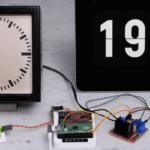A journalist turned special effects technician, you’ll find Hannah making great stuff on YouTube. This #MagPiMonday, we get to know her a little better.
Sometimes you find out that you’ve been training your whole life for something, and it becomes a fantastic new hobby. For us, and many of you reading The MagPi, that ended up being making.

“I grew up really fond of crafts and obsessed with tech, but I didn’t really figure out how to put the two together until much later,” Hannah explains. She makes excellent videos, as HannahMakes, about her wonderful contraptions. “I happened to be working for New Scientist magazine when I started hearing things about the maker movement; people using a blend of traditional techniques and tech to build awesome things at home. It felt like something we should be covering at the magazine, so I kept mentioning how I thought someone should write about it. My colleagues must have got fed up of hearing me whine, because eventually they told me that, if it bothered me that much, perhaps I should write about it. So I did!”
Hannah ended up buying a 3D printer and an electronics kit and jumped in the deep end, staying up late to figure out how to get them all working.

“I wrote a column about the crazy projects I came up with, like teabag-dunking robots, and shoes that call you an Uber when you click your heels together three times,” Hannah continues. “As time went on, I became so obsessed with making that I ended up switching careers to find a job that involved less writing and more building. Now I get to work in a giant workshop full of machines (my favourite is probably the giant 7-axis robot arm), and wonderful, talented people that I get to learn from.”
Where did your YouTube channel come from?
I’d made a few videos for New Scientist magazine and discovered I really enjoyed it – so much so that I wanted to continue doing it after I left the magazine. So, I started my own YouTube channel. I also liked the idea that showing off my projects might help other women to consider tech as a viable hobby or career. Despite an increased focus on inclusivity and diversity, the sad truth is that women are still a minority in the industry (Tech Nation recently reported that “just 26% of the tech workforce are women.”) Besides, it can be an intimidating field with a relatively high barrier to entry, regardless of your gender. So, I hope that by showcasing my work I can help show other women there’s a place for them.

What are your favourite things you’ve made with Raspberry Pi?
One of my favourites was a prop for a TV show. The production team gave us a regular digital alarm clock and asked us to make an exact replica, except an inch bigger and fully controllable. Before working in the film industry, I might have assumed you’d just use a normal alarm clock, but they wanted close-ups of the clock face showing a very specific time and advancing by one minute precisely on cue. There were also LEDs in the translucent body, and they wanted to control the colour and brightness. In the end, we 3D-printed a case and I fitted in a Raspberry Pi running a small LED strip and a Pimoroni HyperPixel touchscreen. I wrote a program using Pygame to display a seven-segment-style clock, and added an invisible button to one corner of the screen, which led to a menu where you could set the time and other options. I also added some buttons on a long cable so they could step forward and backward through time as they needed throughout a scene. It was an extra-memorable project because, once we were finished, my boss let me blow up the original alarm clock in the car park with some pyrotechnics we were testing!

The other project that comes to mind is kind of a bit naughty: I used a Raspberry Pi to hack an old 3D printer. The printer would only work with proprietary cartridges of branded filament that were expensive and tricky to get hold of. The cartridges contained EEPROM memory to store info like serial number and remaining material, which the machine would read, preventing you from opening a cartridge and filling it with your own material. But, some kind geniuses cracked the encryption used on the EEPROM chips, meaning that all you need is a Raspberry Pi and a couple of croc clips to reprogram a cartridge and trick the printer into thinking it’s brand-new. I think it’s justified because it gave a new lease of life to a machine that wasn’t seeing much use any more, and let us experiment with some new materials.

The MagPi #133 out NOW!
You can grab the brand-new issue right now from Tesco, Sainsbury’s, Asda, WHSmith, and other newsagents, including the Raspberry Pi Store in Cambridge. It’s also available at our online store which ships around the world. You can also get it via our app on Android or iOS.

You can also subscribe to the print version of The MagPi. Not only do we deliver it globally, but people who sign up to the six- or twelve-month print subscription get a FREE Raspberry Pi Pico W!
The free PDF will be available in three weeks’ time. Visit the issue page for more details.








